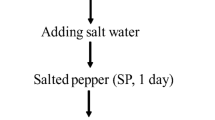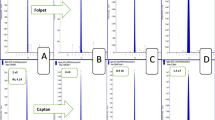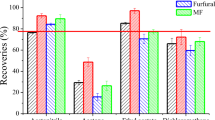Abstract
The use of the direct inlet probe–atmospheric-pressure chemical ionization (DIP-APCI) ion source developed in our laboratory coupled to a high resolution Q-TOF MS for the quantitative analysis of coumarin in different cinnamon samples was demonstrated in this study. Extraction of coumarin from various cinnamon samples was followed by DIP-APCI-mass spectrometry (MS) and liquid chromatography (LC)-MS analysis. For quantification, an external calibration with and without the use of stable isotope-labeled coumarin as internal standard was compared. The results obtained by DIP-APCI-MS and LC-MS were in good agreement. Even without the use of an internal standard satisfying linearity (R 2 > 0.997), recovery (94–104 % for spiking levels between 100 and 5,000 mg/kg) and intra- and interday repeatability (2.2–13.8 %RSD) was demonstrated using DIP-APCI-MS. To reduce the number of samples requiring quantitative analysis, the possibility of semi-quantitative screening of coumarin directly from powdered cinnamon using DIP-APCI-MS was shown. The analysis of woodruff-flavored beverages and cinnamon-flavored chewing gum by DIP-APCI-MS resulted in the formation of an artifact interfering with coumarin detection. As with other ambient ionization methods, special attention has to be paid to possible spectral interferences due to isobaric substances present in the sample matrix or formed from matrix components after ionization. The temperature-programmed vaporization in DIP-APCI-MS combined with the use of stable isotope-labeled coumarin as internal standard helped in recognizing this interference.







Similar content being viewed by others
References
Raters M, Matissek R (2008) Analysis of coumarin in various foods using liquid chromatography with tandem mass spectrometric detection. Eur Food Res Technol 227:637–642
Woehrlin F, Fry H, Abraham K, Preiss-Weigert A (2010) Quantification of flavoring constituents in cinnamon: high variation of coumarin in Cassia bark from the german retail market and in authentic samples from Indonesia. J Agr Food Chem 58:10568–10575
Fotland TO, Paulsen JE, Sanner T, Alexander J, Husoy T (2012) Risk assessment of coumarin using the bench mark dose (BMD) approach: children in Norway which regularly eat oatmeal porridge with cinnamon may exceed the TDI for coumarin with several folds. Food Chem Toxicol 50:903–912
Miller KG, Poole CF, Chichila TMP (1995) Solvent-assisted supercritical-fluid extraction for the isolation of semivolatile flavor compounds from the cinnamons of commerce and their separation by series-coupled column gas-chromatography. J High Res Chromatog 18:461–471
EFSA (2004) Opinion of the scientific panel on food additives, flavourings, processing aids and materials in contact with food (AFC) on a request from the commission related to coumarin, adopted on 6 October 2004. The EFSA Journal 104:1–36
EFSA (2008) Coumarin in flavourings and other food ingredients with flavouring properties, scientific opinion of the panel on food additives, flavourings, processing aids and materials in contact with food (AFC), adopted on 8 July 2008. The EFSA Journal 793:1–15
Abraham K, Woehrlin F, Lindtner O, Heinemeyer G, Lampen A (2010) Toxicology and risk assessment of coumarin: focus on human data. Mol Nutr Food Res 54:228–239
Abraham K, Pfister M, Woehrlin F, Lampen A (2011) Relative bioavailability of coumarin from cinnamon and cinnamon-containing foods compared to isolated coumarin: a four-way crossover study in human volunteers. Mol Nutr Food Res 55:644–653
BfR (2012) Neue Erkenntnisse zu Cumarin in Zimt. Stellungnahme Nr. 036/2012 des BfR vom 27. September 2012. http://www.bfr.bund.de/cm/343/neue-erkenntnisse-zu-cumarin-in-zimt.pdf
Sproll C, Ruge W, Andlauer C, Godelmann R, Lachenmeier DW (2008) HPLC analysis and safety assessment of coumarin in foods. Food Chem 109:462–469
Lungarini S, Aureli F, Coni E (2008) Coumarin and cinnamaldehyde in cinnamon marketed in Italy: a natural chemical hazard? Food Addit Contam A 25:1297–1305
Rychlik M (2008) Quantification of free coumarin and its liberation from glucosylated precursors by stable isotope dilution assays based on liquid chromatography-tandem mass spectrometric detection. J Agr Food Chem 56:796–801
McEwen CN, McKay RG, Larsen BS (2005) Analysis of solids, liquids, and biological tissues using solids probe introduction at atmospheric pressure on commercial LC/MS instruments. Anal Chem 77:7826–7831
Cody RB, Laramee JA, Durst HD (2005) Versatile new ion source for the analysis of materials in open air under ambient conditions. Anal Chem 77:2297–2302
Takats Z, Wiseman JM, Gologan B, Cooks RG (2004) Mass spectrometry sampling under ambient conditions with desorption electrospray ionization. Science 306:471–473
Fussell RJ, Chan D, Sharman M (2010) An assessment of atmospheric-pressure solids-analysis probes for the detection of chemicals in food. Trac-Trends Anal Chem 29:1326–1335
Schurek J, Vaclavik L, Hooijerink H, Lacina O, Poustka J, Sharman M, Caldow M, Nielen MWF, Hajslova J (2008) Control of strobilurin fungicides in wheat using direct analysis in real time accurate time-of-flight and desorption electrospray ionization linear ion trap mass spectrometry. Anal Chem 80:9567–9575
Nilles JM, Connell TR, Durst HD (2009) Quantitation of chemical warfare agents using the direct analysis in real time (DART) technique. Anal Chem 81:6744–6749
Danhelova H, Hradecky J, Prinosilova S, Cajka T, Riddellova K, Vaclavik L, Hajslova J (2012) Rapid analysis of caffeine in various coffee samples employing direct analysis in real-time ionization-high-resolution mass spectrometry. Anal Bioanal Chem 403:2883–2889
Mirnaghi FS, Pawliszyn J (2012) Reusable solid-phase microextraction coating for direct immersion whole-blood analysis and extracted blood spot sampling coupled with liquid chromatography-tandem mass spectrometry and direct analysis in real-time tandem mass spectrometry. Anal Chem 84:8301–8309
Li YJ, Wang ZZ, Bi YA, Ding G, Sheng LS, Qin JP, Xiao W, Li JC, Wang YX, Wang X (2012) The evaluation and implementation of direct analysis in real time quadrupole time-of-flight tandem mass spectrometry for characterization and quantification of geniposide in Re Du Ning Injections. Rapid Commun Mass Spectrom 26:1377–1384
Vaclavik L, Zachariasova M, Hrbek V, Hajslova J (2010) Analysis of multiple mycotoxins in cereals under ambient conditions using direct analysis in real time (DART) ionization coupled to high resolution mass spectrometry. Talanta 82:1950–1957
Vismeh R, Waldon DJ, Teffera Y, Zhao ZY (2012) Localization and quantification of drugs in animal tissues by use of desorption electrospray ionization mass spectrometry imaging. Anal Chem 84:5439–5445
D’Aloise P, Chen H (2012) Rapid determination of flunitrazepam in alcoholic beverages by desorption electrospray ionization-mass spectrometry. Sci Justice 52:2–8
Thunig J, Flo L, Pedersen-Bjergaard S, Hansen SH, Janfelt C (2012) Liquid-phase microextraction and desorption electrospray ionization mass spectrometry for identification and quantification of basic drugs in human urine. Rapid Commun Mass Spectrom 26:133–140
Wu CP, Ifa DR, Manicke NE, Cooks RG (2009) Rapid, direct analysis of cholesterol by charge labeling in reactive desorption electrospray ionization. Anal Chem 81:7618–7624
Hajslova J, Cajka T, Vaclavik L (2011) Challenging applications offered by direct analysis in real time (DART) in food-quality and safety analysis. Trac-Trends Anal Chem 30:204–218
Krieger S, von Trotha A, Leung KS, Schmitz OJ (2013) Development, optimization, and use of an APCI source with temperature-controlled vaporization of solid and liquid samples. Anal Bioanal Chem 405:1373–1381
Matissek R, Steiner G, Fischer M (2010) Lebensmittelanalytik. Springer, Germany
Edwards KG, Stoker JR (1967) Biosynthesis of coumarin—isomerization stage. Phytochemistry 6:655–661
Yang ZY, Kinoshita T, Tanida A, Sayama H, Morita A, Watanabe N (2009) Analysis of coumarin and its glycosidically bound precursor in Japanese green tea having sweet-herbaceous odour. Food Chem 114:289–294
Chernetsova ES, Morlock GE (2012) Assessing the capabilities of direct analysis in real time mass spectrometry for 5-hydroxymethylfurfural quantitation in honey. Int J Mass Spectrom 314:22–32
Acknowledgment
The authors thank Scientific Instruments Manufacturer GmbH (SIM) for providing the direct inlet probe and Phenomenex Inc. for providing the Kinetex column. Sonja Krieger also thanks the Zentrum fuer Graduiertenstudien of the University of Wuppertal for funding.
Author information
Authors and Affiliations
Corresponding author
Rights and permissions
About this article
Cite this article
Krieger, S., Hayen, H. & Schmitz, O.J. Quantification of coumarin in cinnamon and woodruff beverages using DIP-APCI-MS and LC-MS. Anal Bioanal Chem 405, 8337–8345 (2013). https://doi.org/10.1007/s00216-013-7238-x
Received:
Revised:
Accepted:
Published:
Issue Date:
DOI: https://doi.org/10.1007/s00216-013-7238-x




